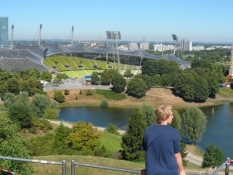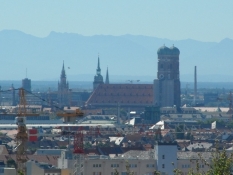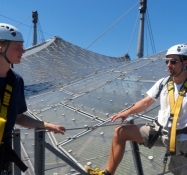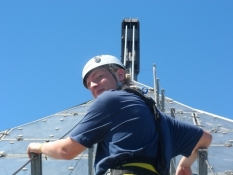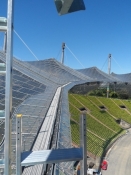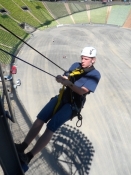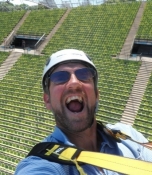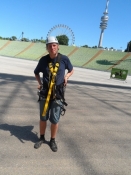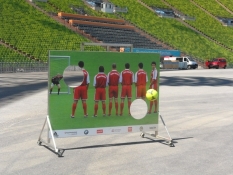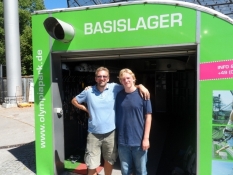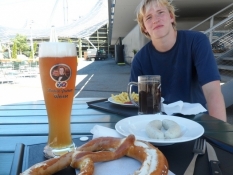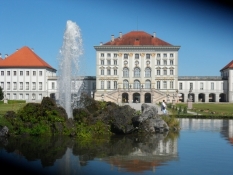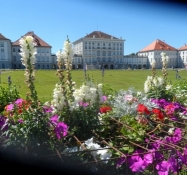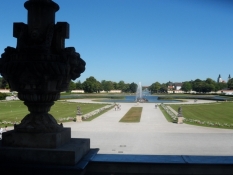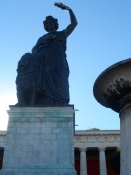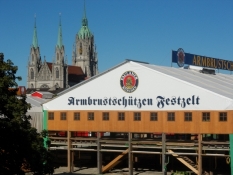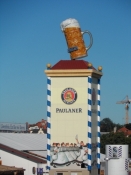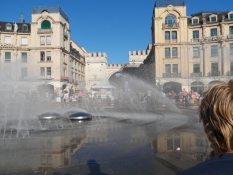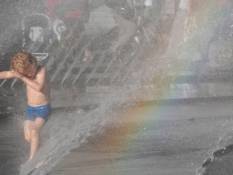Cycle Tour Tour in the Alps 2013
Dag 3: München, dag 3
![]()
Please wait - map data are loading
Added on 25 Aug 2013
last edited by Ottocolor on 28 Aug 2020
Cycle route metrics
ridden
Total distance in km
24
Cumulative elevation gain in m
238
Avg. slope uphill in %
0,99
Cumulative elevation loss in m
238
Information about rights to the gps-track data | |
|---|---|
Rights owner | |
Rights characteristic / license | by-sa: CREATIVE COMMONS Attribution-ShareAlike |
Link to the description of the license | |
GPX file uploaded | by Ottocolor on 18 Nov 2013
|
Track points in total
322
Track points per km (avg)
13
Start/endpoint
Start location
München, Bayern, DE (525 m NHN)
End location
München, Bayern, DE (532 m NHN)
ridden on
01 Aug 2013
Weather
Hot weather (25-26° C) and sunny all day long.
Accommodation
Haus International
Elisabethstraße 87
DE-80797 München
Properties
Bikelanes along big roads, tarmaced bikepaths in the Olympiapark with a gravel path to the top of the Olympia Mountain, tiles paving around the stadium. Rode in heavy traffic on Schleissheimer Strasse.
Sources of information
Bikeline "Cycle atlas Munich", a city plan borrowed from TV2 and a small map, which we got from the hostel Haus International
Remarks
The third day of the bike holiday and also the third day in Munich.
Travel report
Information about copyright | |
|---|---|
Rights owner | |
Rights characteristic / license | by-sa: CREATIVE COMMONS Attribution-ShareAlike |
Link to the description of the license | |
Image has been uploaded | by Ottocolor on 30 Nov 2013
|
Information about copyright | |
|---|---|
Rights owner | |
Rights characteristic / license | by-sa: CREATIVE COMMONS Attribution-ShareAlike |
Link to the description of the license | |
Image has been uploaded | by Ottocolor on 30 Nov 2013
|
Information about copyright | |
|---|---|
Rights owner | |
Rights characteristic / license | by-sa: CREATIVE COMMONS Attribution-ShareAlike |
Link to the description of the license | |
Image has been uploaded | by Ottocolor on 30 Nov 2013
|
Information about copyright | |
|---|---|
Rights owner | |
Rights characteristic / license | by-sa: CREATIVE COMMONS Attribution-ShareAlike |
Link to the description of the license | |
Image has been uploaded | by Ottocolor on 30 Nov 2013
|
Information about copyright | |
|---|---|
Rights owner | |
Rights characteristic / license | by-sa: CREATIVE COMMONS Attribution-ShareAlike |
Link to the description of the license | |
Image has been uploaded | by Ottocolor on 30 Nov 2013
|
Information about copyright | |
|---|---|
Rights owner | |
Rights characteristic / license | by-sa: CREATIVE COMMONS Attribution-ShareAlike |
Link to the description of the license | |
Image has been uploaded | by Ottocolor on 30 Nov 2013
|
Information about copyright | |
|---|---|
Rights owner | |
Rights characteristic / license | by-sa: CREATIVE COMMONS Attribution-ShareAlike |
Link to the description of the license | |
Image has been uploaded | by Ottocolor on 30 Nov 2013
|
Information about copyright | |
|---|---|
Rights owner | |
Rights characteristic / license | by-sa: CREATIVE COMMONS Attribution-ShareAlike |
Link to the description of the license | |
Image has been uploaded | by Ottocolor on 30 Nov 2013
|
Information about copyright | |
|---|---|
Rights owner | |
Rights characteristic / license | by-sa: CREATIVE COMMONS Attribution-ShareAlike |
Link to the description of the license | |
Image has been uploaded | by Ottocolor on 30 Nov 2013
|
Information about copyright | |
|---|---|
Rights owner | |
Rights characteristic / license | by-sa: CREATIVE COMMONS Attribution-ShareAlike |
Link to the description of the license | |
Image has been uploaded | by Ottocolor on 30 Nov 2013
|
Our last day in Munich was the day I had booked a guided tour of the Olympia Stadiums tent roof with a descent along a rope. ("Abseilen" is the word in German. "Rapelling" is not the Danish word as it is done down a surface, a tower, grain silo ect) Originally, I planned to do it the first day, but then plans changed when I did not could get reservations for our bikes on the train and we chose to go by car. So the first day went with driving to Munich and I rebooked the Olympiastadion- trip on the phone from home. And it turned out to be a perfect day for such a 'high' walk as the weather was completely cloudless and the air was crystal clear.
The first goal, which was not very far from our hostel, was the so-called Olympia Mountain. It 's the first thing you come to when you come cycling from the south on Spiridon-Louis-Ring. This road which is closed to cars, winds all the way round the olympia park is named after the original marathon runner, namely the winner of the first marathon at the first Olympic Games of the modern era, 1896 in Athens. Here they had wanted to commemorate the messenger Phillippides who ran the 42,195 km from Marathon to Athens to announce the Greek Navy's victory at the Battle of Marathon 490 BC. Olympia park was designed, when Munich had been awarded the hosting of the Olympic Games in 1972. Before that there had been a test airfield here, which had been closed earlier, so the area, which already then lay within the city area, was unused, except that it had acquired a great deal of the rubble, which was a result of world War II devastation in the center. And the olympia mountain that Simon and I rode up on top of precisely consists of waste from the war, so it is an artificial hill in the flat cityscape. Therefore the view from up there is indeed magnificent, especially on such a clear day like today. The whole area is planted with lawns, as it must be a mammoth task to water and mow it all. We had actually to wait for a water cannon let a jet of water pass before we cycled all the way up. The first short but tough climb of the Tour in the Alps. And we could really see the Alps on the background of the city center. From here it was even clearer how much the massive Frauenkirche accounts for in the city silhouette. On the other hand, there are fine views of olympia park with the stadium, several multi-purpose sports halls, the swimming hall and the Olympic tower, a typical television tower, which does not have anything to do with the Olympics, since it was built several years before Munich was chosen to host the Olympics. From the 'mountain', it was also clear how the so-called tent roof linked the various buildings. It was very futuristic in the early 70s and still does to date. The idea was to create a camp atmosphere in the park, putting up large masts and hitch a 'tent canvas' out from them. The 'canvas' consists of transparent plexiglass plates which are riveted together by means of wires. In front of the buildings is the long Olympia lake where all sorts of water sports were going on on such a perfect summer day. It is a long way to the sea from here, and then such a shallow lagoon in the city can be used to waterski on. The water comes from one canal, which also provides water to the castle lakes and fountains at the castle of Nymphenburg, which we were to visit later that day.
Behind the park we could see the so-called Olympic village, the apartment blocks where the athletes stayed during the Olympics. It was here, there was a terrorist attack on the Israeli athletes, which caused many deaths and which cast a long, dark shadow over the Olympics, which until then had been "die Heiteren Spiele", the merry games. I remember I saw it all on TV at home. And when today I looked over at the stadium, I remember how all the flags on the edge of the stadium flew on half pole for the memorial service for the victims, and how the IOC President Avery Brundage in a serious and heavy voice announced: "The games must go on!". Yes, the world was not to be intimidated by terrorists, and especially Germany, the German media and the German police had learned a lot about how not to act in a similar situation. Where the stadium and the park still looks modern the Olympic village seems a dull 70's concrete slums, where ordinary people live today. East of the blocks is BMW 's factory area. It covers a huge area, but unlike many others, BMW still develops and manufactures almost all of its cars and motorcycles in one place. Most notable in the cityscape is the so-called four-cylinder, the administrative headquarters, which is designed as four pillars together in a square. Also the view of the English Garden is matchless up here. You can really see how big the park is.
But now it was time to roll down the hill and into the Olympic Park. Here they made ready for opening a fun fair with fun rides including a large Ferris wheel. But we were interested only in the Olympic buildings. We began on the central Coubertin square, named after the IOC's first Secretary General. Here many of the tent pieces converge. Everything seems bright as the sun shines through the plexiglas plates. From the square, where there, of course, is a beer garden, including large trees in pots, we cycled slowly around the large sports halls, several of which are being renovated. They are still used for both sports and concerts, like the olympia stadium, which has its main entrance just off Coubertin Square. On the way back to the stadium we threw a glance into the large swimming hall. Here Mark Spitz, USA, won his seven gold medals in 1972. And Kornelia Ender from the GDR had proved to the world and especially West Germany that East Germany was superior in sports. Later it turned out that the swimmers, among many other athletes, of course, also from other countries, had been heavily doped. But the female GDR swimmers stood as a symbol of doping and its results. I remember them as some burly, broad-shouldered, masculine women with deep voices. The rumor said they shaved and had no menstrual periods. Today there was public access to the hall. It was funny to stand and look out over the swimming pool and feel the chlorine smell in the nostrils. It was more weather to swim outside. Outside the swimming pool the fun fair had started, and there were so many people that we gave up cycling but wheeled the bikes over to the stadium. On the way I was caught by a newspaper sales agent of the Süddeutsche Zeitung sells for, who made me book an internet subscription to the newspaper after our return to Odense. Now what was that good for? We obviously had too much time before we had to be at the stadiums main entrance to begin our guided trip up the tent roof stadiums.
After a handsome payment, we were met by our guides. There were only 6-7 guests, and Simon and I were the only ones who had ordered an English tour, so we had our guide to ourselves. First we went over to a container, they called the base camp and were equipped with harnesses and helmets. I also secured my camera so I could take pictures without fear of losing it. We were also given a "Waldi", which is a tow rope with a sled for the rail running along the roof edge of the stadium. Thus, we were also secured. The name Waldi is a common German dogs name and also and the name of the 1972 Olympics 's mascot. We all had to walk the 'dog' and we had to hold the sled at a certain angle through the vertical posts the rope was fixed to. After the ascent the guidance began. We got a lot to know about the Olympics, the stadium and the special tent roof. It was also here FC Bayern had his home until 2006, and the move to the Allianz Arena. I also thought that here Gerd Müller scored the decisive goal in the World Cup final in 1974 to make it 2-1 on a typical rotary shot of his. He could score from any position, even lying down as he did against Yugoslavia earlier in the World Cup in 1974. The guide spoke English quite well. Simon at least understood him very well, although his German accent, like the Allianz Arena on the first day, was unmistakable. We also enjoyed the view from up there. At one point we had to go only up to one of the peaks, where the roof was attached to a mast. We were up high there, and we spent a lot of time just standing and looking around. About half way around the roof that spans over the western half of the stadium, we reached the place where we were to be lowered in a rope. The other half of the stadium has no roof. This must have been the bleachers. Simon and I looked down at the ground. There was no lawn, but a tarmaced space. The stadium is now used only for concerts, so it's more convenient that way. There was a long way down! I asked Simon, who is slightly acrophobic, how he felt about having to dangle from a rope, 40 meters above the ground, but he just nodded grimly and said he would do it. But he was not looking forward to it, I could see. Everything seemed, however, rock-solid and well thought out and I got sensible answers to all the questions I peppered the guides with. Simon was more calm while we had the procedure explained and had the rope fixed to our belt. The guide opened a hatch, and Simon went backwards to the edge and was slowly lowered, starting with his feet on the edge, free-floating in the rope. He had to keep his feet on the edge as long as possible, then it turned out easy. And we went very slowly and smoothly downward with a break about midway down. I saw more to the sides and upwards, because when I looked down I felt tickles in my stomach. But the tarmaced surface approached and an object on it attracted one's attention. It was a wooden "goal wall" with two holes, and that is well-known from a sports magazine on German television. It was decorated with Bayern players, and Simon and I tried to hit the holes with a football, three shots at the bottom right and three on the top left. Just like on TV. But we didn't score once. But it was fun entertainment while we waited for the other participants, who had been guided in German, were lowered down from the roof. When everybody was down, we went to the exit, and were stripped of our equipment at the base camp. Now it was time for lunch!
Information about copyright | |
|---|---|
Rights characteristic / license | by-sa: CREATIVE COMMONS Attribution-ShareAlike |
Link to the description of the license | |
taken over / edited on | 12 Dec 2013
|
taken over / edited by |
|
Information about copyright | |
|---|---|
Rights owner | |
Rights characteristic / license | by-sa: CREATIVE COMMONS Attribution-ShareAlike |
Link to the description of the license | |
Image has been uploaded | by Ottocolor on 30 Nov 2013
|
Information about copyright | |
|---|---|
Rights owner | |
Rights characteristic / license | by-sa: CREATIVE COMMONS Attribution-ShareAlike |
Link to the description of the license | |
Image has been uploaded | by Ottocolor on 30 Nov 2013
|
Information about copyright | |
|---|---|
Rights owner | |
Rights characteristic / license | by-sa: CREATIVE COMMONS Attribution-ShareAlike |
Link to the description of the license | |
Image has been uploaded | by Ottocolor on 30 Nov 2013
|
Before lunch in the beer garden at the Coubertin Square could be enjoyed, I just had to raise some cash, and that turned out to be quite a challenge in Olympia Park. Simon sat and waited in the ' shadow ' of the transparent roof while I sped around to find a cash dispenser. At last I succeeded after several failed attempts, but was the queue for food and beverages was fortunately not long. So soon I sat with my Bavarian weisswurst lunch with a large brezn and a weissbier in front of me. It doesn't get any more Bavarian. Really weisswurst is to be served before noon. It tolerates no midday bells, it is said. It must be completely fresh and cooked the same morning. In addition, a real Munich-man would never eat the skin. He would suck the meat out of the skin. Well, they tasted good anyway. I do not remember what Simon had, but it was definetely far less Bavarian and more profane.
After lunch it was time to leave the Olympia Park. Originally, Simon and I planned to visit the unique and vast engineering and science museum Deutsches Museum, located on an island in the River Isar south of the centre. But it had grewn so late now that we agreed that there was not enough time for a museum that requires most of a day if you just want to see a small part of it. So we agreed to save it for another time and cycle out to another of Munich's major sights: the palace of Nymphenburg, a 4-5 km to the west. And so we did.
The last part of the road went along a canal, which belongs to the canal system, which also provides water to the olympia lake. The water is drawn from the river Würm, a tributary of the Isar. The road was here elegantly tree-lined on both sides of the canal until it broadened onto a large square in front of the palace. Here, the channel expanded into a large lake with swans and a large fountain in the middle. However, it was not turned on. We parked the bikes at a hedge and went to the lake by foot. Now we were going to have a look at the palace.
Nymphenburg is one of Munich's main attractions with over 300,000 visitors a year. It is the Wittelsbachers former summer residence and thus the counterpart to the winter residence in the center, which we had visited on the first day. It was built as a gift from the prince to the princess on the occasion that she had borne him a long missed crown heir. It happened in 1661. The first building was not so grand, but the crown heir, the future prince Max Emanuel, himself came to expand the palace considerably. The style is as so often baroque, but there have been changes in the rococo and classicism. The large circular blank with several mansions next to each other in a round shape was unique to the architectural time, and it works also quite rich. Simon and I decided to stay outside, but I snuck up the stairs and looked through the windows. Here was a guided tour going on in one of the splendid halls. The decor seemed grandeour out here, entirely in the Baroque style. It was in one of these rooms that the famous King Ludwig II had been born, he who was a bit crazy with all his castles, most notably the castle of Neuschwanstein, Germany's biggest tourist attraction, which we were to visit later on the Alpine trip. Also Ludwig I, who loved pomp, probably enjoyed life here. Simon also came up the stairs and took a peek through the windows. You never know whether you will be chased away by some meddlesome museum employee, but it did not happen now. Back on the ground again, we walked through a gate in the palace out on the garden side. Here opened the whole aristocratic world of garden art before our eyes. A huge park it was. Nearest to the palace in French Baroque style, and it reminded well of the model for all absolutism palaces, Versailles near Paris. Further out, the park is designed as an English landscape park, but we did not make it out there. It was a very hot day, and when I suggested Simon to go all the way along the canal, which divides the park into a northern and a southern part and up to the great cascade, it was not a thing he liked to hear. Therefore, we made with a little trip to a pond with some fat geese and a nice look at the palace. There were many statues along the garden parths. Soon we chose, however, to admire them and the palace facade from a bench in the shade of some trees. No wind blew here and the air stood still. Melting hot! In addition, thirst for coffee had risen, but no palace café could be seen. I felt happy that Simon did not want to walk anymore. Instead we went into the palace bookshop. It was relatively cool here, and we walked around and looked at the beautiful books. I bought a picture book about Munich. Simon also bought something and thus came to lose his key to the room at the hostel. He found out when he could not find it anywhere after we had cycled from there, but fortunately it had been found in the store, and a clerk handed it to him after having properly verified that he was its rightful owner. Simon was happy. He had just escaped a fine of € 100 to the hostel!
After the palace visit, we quickly found a sidewalk café, unfortunately right next to a very busy road and it was afternoon rush hour now. But the coffee and cake was relieving. Nice! Afterwards we cycled along the large and somewhat boring Arnulfstrasse which ends flush at the main railway station. There was heavy traffic all the way, also on the bike path. Slightly distressing. Our goal was now the great statue of Bavaria and the Bavarian 'hall of honour' and the Theresienwiese, the site where the Oktoberfest takes place. When we got to the now wel-known bridge across the railway, the Donnersberger Bridge, we turned south and were soon near the hotel where the Caddy was parked. This time we didn't pay it a visit, but swung to the east. This neighborhood, called Westend and later Schwanthalerhöhe is quite posh and the traffic was regulated here, but it was a hassle for cyclists, because they have to stop twice for red light to pass the intersections along Kazmairstrasse. Eventually we ended up, however, high above the Theresienwiese after having some trouble with crossing a busy road. I could feel I was growing tired of city traffic and was glad to get out into the countryside and away from especially all the cars.
You could see they were preparing for this year's Octoberfest, which, funny enough, always starts on the penultimate weekend of September. It lasts only into the week of October. The large 'beertents', which are not really tents, were already erected, and I doubt whether they tear them down completely after the Octoberfest. I suggested Simon to wheel the bikes down the grass bank, but he felt that there wouldn't be any access while they were working. It turned out later that he had been completely right. But I wanted to have a closer look at Bavaria, the large seated bronze statue depicting a Bavarian patron heroine who is enthroned on a hill above the 'party meadow', how the Octoberfest amusement park is called. We arrived at the foot of the stairs leading up to Bavaria's base. Behind her is a so-called 'hall of honour' (Ruhmeshalle) with columns. Everything is meant to symbolize Bavaria's greatness, and none other than Louis I had let it build in the years of 1843-50, that is, at the height of the age of restauration and the National Romantic period. In her hand Bavaria holds a victory wreath, which she is about to put on her own head. They were not afraid of boasting in this age. If people had known what all this megalomania, which almost all European countries showed in a greater or lesser degree, one day would result in, they perhaps been a bit more restrained. But nowhere people felt more nationally proud and rattled its weapons more than in Germany, and it was boosted by victories in the wars against Denmark (1864), Austria (1866) and France (1871). First World War I put, alas only temporarily, an end to the thinking of national greatness. But okay, the statue could have imagined Bismarck as a Roman gladiator with a sword (as in Hamburg), then an adorable Bavaria is preferable. At her side is seen a Bavarian lion.
After the visit to Bavaria, from where you had a fine view of the 'meadow', it was time to find the center of Munich and just relax. Down here in the southern part of the Theresienwiese, there were no workers rolling in beer kegs, so here we cycled across it. I noticed hte Paulaner 'tent' with a tall tower with a liter mug of beer on top next to it. On the other side of the 'meadow' Ludwigsvorstadt began, a rather classy quarter with quiet streets. Here we were lucky that we chose the street through the large university hospital. It does not consist of any high buildings, but covers a vast area with low, older buildings. In this way, it becomes part of the city, and that's how it's meant to be. We could easily cycle while cars are not allowed to drive through. Yihaa. We came out onto the Altstadtring, the ring road around the old town, ie the center, just off one of the three surviving city gates, the Sendlinger Gate. We'd like to head north on the ring road and had to cross it, but it was impossible where we were. Instead we wheeled the bike on the sidewalk. At least there was shade here. And then Simon spotted a store that sold cheap sunglasses and he found just the glasses and the brand he wanted. A little later we found a pedestrian crossing and turned to the left.
Information about copyright | |
|---|---|
Rights characteristic / license | by-sa: CREATIVE COMMONS Attribution-ShareAlike |
Link to the description of the license | |
taken over / edited on | 18 Dec 2013
|
taken over / edited by |
|
Information about copyright | |
|---|---|
Rights owner | |
Rights characteristic / license | by-sa: CREATIVE COMMONS Attribution-ShareAlike |
Link to the description of the license | |
Image has been uploaded | by Ottocolor on 30 Nov 2013
|
Information about copyright | |
|---|---|
Rights owner | |
Rights characteristic / license | by-sa: CREATIVE COMMONS Attribution-ShareAlike |
Link to the description of the license | |
Image has been uploaded | by Ottocolor on 30 Nov 2013
|
Information about copyright | |
|---|---|
Rights owner | |
Rights characteristic / license | by-sa: CREATIVE COMMONS Attribution-ShareAlike |
Link to the description of the license | |
Image has been uploaded | by Ottocolor on 30 Nov 2013
|
Information about copyright | |
|---|---|
Rights owner | |
Rights characteristic / license | by-sa: CREATIVE COMMONS Attribution-ShareAlike |
Link to the description of the license | |
Image has been uploaded | by Ottocolor on 30 Nov 2013
|
Information about copyright | |
|---|---|
Rights owner | |
Rights characteristic / license | by-sa: CREATIVE COMMONS Attribution-ShareAlike |
Link to the description of the license | |
Image has been uploaded | by Ottocolor on 30 Nov 2013
|
Information about copyright | |
|---|---|
Rights owner | |
Rights characteristic / license | by-sa: CREATIVE COMMONS Attribution-ShareAlike |
Link to the description of the license | |
Image has been uploaded | by Ottocolor on 30 Nov 2013
|
Now we were over in the sunny side of this part of the ring road, appropriately enough called Sonnenstrasse (sun road). Of course there was also a bike path here. It is the exception, that there is no bike path is. But we should try that later that day. So far, the goal was a sports shop at Karlsplatz or Stachus, how the Munichers call the square. I had run out of gas on the first day and wanted to buy two different gas containers to my two cookers. When we came onto Stachus, I was, however, so overheated that I simply just had to cool down a bit in the fountain that fills a good part of the square. It is designed with the water jets coming out of the tiles, and you just find a place where the water droplets are atomized, so that the water not completely splashes on your clothing. Simon was not crazy about this exercise. But I discovered several adults who did what I did and found the cooling exceedingly pleasant. Some children in underpants were of course totally wet and enjoyed it tremendously. How are teenagers just in between. Or are we adults just on our way to behaving like kids again? Stachus has got its name from a tavern that stood here once, called Zum Eustachius. The official name Karlsplatz it bears because of Karl's gate, located in the axis from thee Central Station to Marienplatz, Munich's so Town hall square. The gate is basically medieval, but has been destroyed and rebuilt so many times that one can hardly say that it is preserved, because every time they added and changed things in that time's spirit. It is a gateway into the large pedestrian street of Neuhauser Strasse. Here we found the sports shop, we were looking for, but they only had one small gas container, I needed. The other was missing a thread, but I bought it anyway, because maybe it could well be pressed over the cooker's hose, but of course it turned out hopeless, and I left it at the hostel room. So we had to do with one cooker. Now I could at least make coffee! Outside on Karlsplatz a political demonstration was going on. Some anti Muslims brawled about a mosque that allegedly was going to be built on Stachus, and then probably everything that people love would be prohibited. And a lot of other xenophobic bullshit. Simon, who did not understand a word of it and I quickly turned our backs to it. That meant we faced the huge building to the west, called Justizpalast, the city court building. Something of an ornate monstrosity in the National Romantic style. We could only wheel the bikes across the road here, but I thought there was a bicycle crossing further along, but we came to ride a detour. It is one of Munich's most crowded places, and we had to cross several roads before we were finally on the right track alongside the old botanical garden. This sounds nice, but here the bike lane suddenly stopped, and we were exposed to the roaring traffic. Immediately the city seemed somewhat more bike hostile, but we had tried it then. The goal was really just to get home to the hostel and get some rest on the beds. In addition, we went a little wrong, but eventually came out on Schleissheimer Strasse. It alsol had no bike path, but indstead lots of parked cars. One good thing was that we saw a sports pub that advertised with the Premiere-sign (a sports channel on German television) in the window, not far from Haus International. Here we would watch the Audi Cup final between Bayern Munich and Manchester City and have something to eat at the same time.
But first it was time for a rest and some water in our room. It was really a hot day. But the day after, it was going to be even hotter, they said. So it was nice thinking that we went out of the city and cycling along the river Isar south towards the Alps. So far we cycled though, just to the sports pub Maxvorstadt. It was almost empty when we entered. But they would show the match we wanted to watch. And they also sold some food. Splendid. The menu was very sparse, but it was cheap and that was nice, as Munich had been a bit of an expensive aquaintance for my wallet. The only problem was that the portions were so small that we had to order 'the other dish' too. Well, then we had tasted the entire culinary offerings there. And it was highly indifferent food other than it filled our stomach. The football was more important. First we were told that the Audi Cup's bronze match between Milan and FC São Paulo had ended 1-0 to the former club. No surprise. Then the final between the local heroes from Bayern and Manchester City began. Later this year, the two clubs would also meet each other in the Champions League, what they didn't know yet, so it was a good preparation. Bayern attacked at full blaze and performed a volley of near misses, so we heard many sighs from the spectators at the pub. It was a good match, also the English team (although there are not many English players on the team) improved. Two huge chances to Samir Nasri just before and after the break, but then scored newly signed Alvaro Negredo 1-0 after an hour of play. Long faces could be seen in the sold-out Allianz Arena. But just five minutes later Bayern was given a lucky penalty for hands, and Thomas Müller could easily make it 1-1. Thank you for the gift and spirits rose at the tables. Now the local heroes had started, and again just five minutes later Mario Mandzukic headed in to the finish score of 2-1. Bayern had won the Audi Cup, and Pep Guardiola his first tournament with Bayern. And that was what he had come for. However, it must be a thankless task to replace a man, Jupp Heynckes, who had won The Triple in the previous season. It's impossible to top that. But I guess its about taking one game at a time and other platitudes. Bayern's form seemed certainly very fine from the beginning, and now they were ready for the season's first Bundesliga match on Friday of the following week.
After the match I called home from the phone and we cycled back to the hostel to pack mostly along the following day. Now they were three days in Munich ended and Alpine tour was going to live up to its name. In Munich itself is flat as a pancake except those artificial mountains of rubble.
Information about copyright | |
|---|---|
Rights characteristic / license | by-sa: CREATIVE COMMONS Attribution-ShareAlike |
Link to the description of the license | |
taken over / edited on | 20 Dec 2013
|
taken over / edited by |
|

